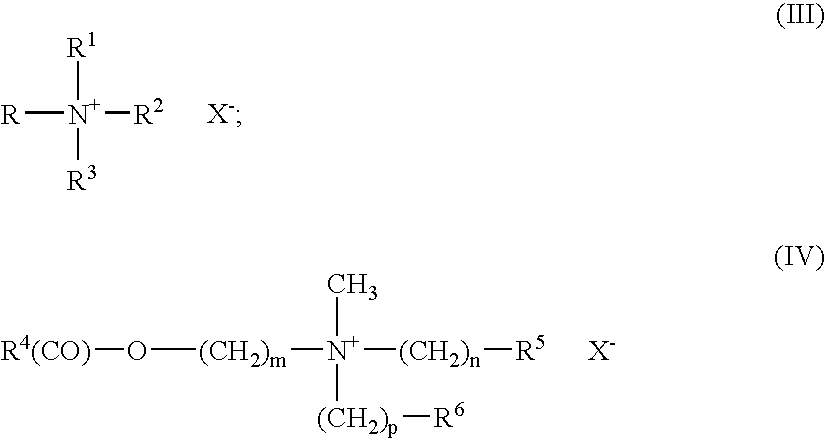Consumer products having varying odors
a technology of consumer products and odors, applied in the direction of detergent powders/flakes/sheets, detergent compounding agents, disinfection, etc., can solve the problem of stocking up of his products, e.g. of detergents and cleaners, remains problemati
- Summary
- Abstract
- Description
- Claims
- Application Information
AI Technical Summary
Benefits of technology
Problems solved by technology
Method used
Image
Examples
example 1
[0454]A solid, unperfumed detergent was divided in terms of amount in the ratio 1:2. Component 1 was then perfumed with a perfume oil of scent direction “citrus freshness” by spraying; component 2 was perfumed with a colored perfume oil of scent direction “balsamic, caring”.
[0455]Via separate conveyor belts, the two partial streams were poured into a rotating, oblique funnel which fed into the packaging to be filled. Through appropriate choice of the belt speeds, which were each varied independently of one another, it was possible to adjust the mixing ratio of components 1 and 2 such that it was not constant over the duration of the filling operation.
[0456]This resulted in a product in which two differently smelling perfume oils were not evenly distributed in the product in proportion to one another.
example 2
[0457]A solid, unperfumed compact detergent with spherical basic structure was separated into two identical partial streams using a wedge-shaped insertion aid on a conveyor belt. One partial stream was sprayed with a very liquid perfume oil of the “Eau de Cologne” type, the other partial stream, to which colored speckles had also been added, was supplemented with a significantly more viscous perfume oil of the “flower accord” type. The two partial streams were introduced into the packages through a chute “arbitrarily”, i.e. by the chance principle, to give a layer structure of the detergent in the package. I.e. detergent layers perfumed with the perfume oil of the “Eau de Cologne” type and detergent layers perfumed with perfume oil of the “flower accord” type each alternated several times in one and the same package in an irregular manner, the ratio being controllable between 80:20 and 20:80, based on the overall package. This resulted in a product in which two differently smelling ...
example 3
[0459]A liquid detergent was produced as base mass and provided with a perfume of the “mandarin lemon” type. Another, differently smelling perfume oil composition II was introduced into particles, which were then suspended in the liquid detergent in such a way that afterwards they neither rose up nor sank. The particle collective which was incorporated into the liquid detergent comprised in each case the same perfume oil composition II, based on the individual particles, but in quite different concentrations. The result was therefore a product in which two differently smelling perfume oils were not evenly distributed in the product in proportion to one another.
PUM
 Login to View More
Login to View More Abstract
Description
Claims
Application Information
 Login to View More
Login to View More - R&D
- Intellectual Property
- Life Sciences
- Materials
- Tech Scout
- Unparalleled Data Quality
- Higher Quality Content
- 60% Fewer Hallucinations
Browse by: Latest US Patents, China's latest patents, Technical Efficacy Thesaurus, Application Domain, Technology Topic, Popular Technical Reports.
© 2025 PatSnap. All rights reserved.Legal|Privacy policy|Modern Slavery Act Transparency Statement|Sitemap|About US| Contact US: help@patsnap.com



